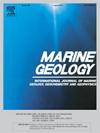Provenance of sediments in the northern shelf of the South China Sea: Insights from Pb isotopes in detrital K-feldspar
IF 2.2
3区 地球科学
Q2 GEOSCIENCES, MULTIDISCIPLINARY
引用次数: 0
Abstract
The South China Sea is the largest collection area of fluvial sediments among the semi-closed marginal seas, offering a desirable geological window for studying the source-to-sink transport process of terrigenous sediments in global marginal seas. K-feldspar is a common rock-forming mineral that is likely representative of the source terranes and could offer a more unbiased constraint on the sediment routing system. Moreover, its susceptibility to weathering prevents it from undergoing more than one sedimentary cycling, thereby providing a better indication of the material's primary source. In this study, Pb isotopes in detrital K-feldspars were analyzed on the northern shelf of the South China Sea with the aims of tracking the provenance of sediments and understanding the sedimentary process in the continental margin. The results show that the compositions of 206Pb/204Pb isotopes in detrital K-feldspars are mainly concentrated in the range of 18.5 to 19.0, with a wide range of 207Pb/204Pb ratios from 15.1 to 16.7. Quantitative provenance results indicate that the detrital K-feldspar primarily originated from the Pearl River catchment (55 %) and southeastern Chinese mainland (37 %), with minor contributions from Taiwan Island (8 %). For the Pearl River system, the Xi River is the most important sediment contributor, while the Bei River also provides a large amount of sediments. In contrast to detrital zircons, conspicuous differences in provenance were discerned for the two distinct proxies. This discrepancy arises from variations in the density and volume of K-feldspar and zircon grains, leading to their distinct sedimentary patterns during transportation. The study emphasizes the limitations of relying solely on a single proxy and highlights the utility of Pb isotopes in detrital K-feldspar for understanding the sedimentary processes within the marginal source-to-sink systems.
南海北部陆架沉积物的物源:来自碎屑钾长石Pb同位素的启示
南海是半封闭边缘海中最大的河流沉积集散地,为研究全球边缘海陆源沉积物源-汇输运过程提供了良好的地质窗口。钾长石是一种常见的造岩矿物,可能代表了源地体,可以为沉积物路线系统提供更公正的约束。此外,它对风化的敏感性使它不能经历一次以上的沉积旋回,从而更好地表明物质的主要来源。本文对南海北部陆架碎屑钾长石中的Pb同位素进行了分析,目的是为了追踪沉积物的物源,了解大陆边缘的沉积过程。结果表明,碎屑钾长石中206Pb/204Pb同位素组成主要集中在18.5 ~ 19.0范围内,207Pb/204Pb比值在15.1 ~ 16.7范围内变化较大;定量物源结果表明,碎屑钾长石主要来自珠江流域(55%)和中国大陆东南部(37%),台湾岛贡献较小(8%)。对于珠江水系来说,西河是最重要的输沙源,北河也提供了大量的输沙源。与碎屑锆石相比,两种不同的代用品在物源上存在显著差异。这种差异是由于钾长石和锆石颗粒的密度和体积的变化,导致它们在运输过程中具有不同的沉积模式。该研究强调了仅依赖单一代理的局限性,并强调了碎屑钾长石中Pb同位素对理解边缘源-汇体系内沉积过程的实用性。
本文章由计算机程序翻译,如有差异,请以英文原文为准。
求助全文
约1分钟内获得全文
求助全文
来源期刊

Marine Geology
地学-地球科学综合
CiteScore
6.10
自引率
6.90%
发文量
175
审稿时长
21.9 weeks
期刊介绍:
Marine Geology is the premier international journal on marine geological processes in the broadest sense. We seek papers that are comprehensive, interdisciplinary and synthetic that will be lasting contributions to the field. Although most papers are based on regional studies, they must demonstrate new findings of international significance. We accept papers on subjects as diverse as seafloor hydrothermal systems, beach dynamics, early diagenesis, microbiological studies in sediments, palaeoclimate studies and geophysical studies of the seabed. We encourage papers that address emerging new fields, for example the influence of anthropogenic processes on coastal/marine geology and coastal/marine geoarchaeology. We insist that the papers are concerned with the marine realm and that they deal with geology: with rocks, sediments, and physical and chemical processes affecting them. Papers should address scientific hypotheses: highly descriptive data compilations or papers that deal only with marine management and risk assessment should be submitted to other journals. Papers on laboratory or modelling studies must demonstrate direct relevance to marine processes or deposits. The primary criteria for acceptance of papers is that the science is of high quality, novel, significant, and of broad international interest.
 求助内容:
求助内容: 应助结果提醒方式:
应助结果提醒方式:


